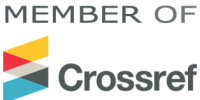Designing a Portfolio Risk Management Model Using Fundamental Analysis and Multi-Objective Evolutionary Optimization
Keywords:
Portfolio risk management, fundamental analysis, multi-objective evolutionary optimization, Tehran Stock Exchange, genetic algorithms, portfolio optimizationAbstract
This study aimed to develop and validate a portfolio risk management model tailored to the Tehran Stock Exchange (TSE) that integrates fundamental analysis with Multi-Objective Evolutionary Optimization to simultaneously enhance return, control risk, and improve downside protection. This quantitative study analyzed all non-financial firms listed on the TSE from July 2023 to July 2024. Firms were first screened using ten fundamental indicators—ROE, ROA, EPS, P/E, P/B, D/E, current ratio, operating cash flow ratio, revenue growth, and net profit margin—and ranked using the Analytic Hierarchy Process (AHP). The top 50 firms were selected as the candidate set for optimization. Portfolios were then constructed and optimized through the Non-dominated Sorting Genetic Algorithm II (NSGA-II), aiming to maximize expected return, minimize variance, and improve Value at Risk (VaR) at the 95% confidence level. Out-of-sample backtesting was conducted, and performance was compared against the market index TEDPIX and a traditional Mean-variance optimization model based on Harry Markowitz’s framework. The optimization produced a well-defined Pareto frontier, with portfolios demonstrating a clear risk-return trade-off. Intermediate-risk portfolios achieved the highest Sharpe Ratio and Sortino Ratio values, indicating optimal risk-adjusted performance. Compared to TEDPIX and the Markowitz model, the optimized portfolios delivered significantly higher average monthly returns (up to 2.7% vs. 1.2%), lower volatility, smaller maximum drawdowns, and higher cumulative wealth. Statistical tests confirmed that these excess returns were significant (p < 0.05), highlighting the superior performance and resilience of the proposed model. Integrating fundamental analysis with multi-objective evolutionary optimization effectively enhances portfolio performance and risk control in the Iranian market.
References
Aghamohammadi, A., Ohadi, F., Sigholi, M., & Banimahd, B. (2022). Presenting a Model for Evaluating and Optimizing Risk Related to Selecting a Bank's Currency Portfolio Combined with Digital Currencies. Research in Organizational Resource Management, 12(2), 31-57.
Bonabi Ghadim, R., Vaez, S. A., & Ensani, R. (2022). The Effect of Intellectual Capital on Sustainability Performance Reporting and Business Strategy. Financial Accounting Research, 14(2), 63-90. https://doi.org/10.22108/far.2022.133847.1890
Cox, S. H., Lin, Y., Tian, R., & Zuluaga, L. F. (2012). Mortality Portfolio Risk Management. Journal of Risk & Insurance, 80(4), 853-890. https://doi.org/10.1111/j.1539-6975.2012.01469.x
Dallagnol, V., van den Berg, J., & Mous, L. (2009). Portfolio management using value at risk: A comparison between genetic algorithms and particle swarm optimization. International Journal of Intelligent Systems, 24(7), 766-792. https://onlinelibrary.wiley.com/doi/abs/10.1002/int.20360
Dunis, C. L., Middleton, P. W., Karathanasopolous, A., & Theofilatos, K. (2019). Artificial Intelligence in Financial Markets. Springer. http://repo.darmajaya.ac.id/5259/1/Artificial%20Intelligence%20in%20Financial%20Markets_%20Cutting%20Edge%20Applications%20for%20Risk%20Management%2C%20Portfolio%20Optimization%20and%20Economics%20%28%20PDFDrive%20%29.pdf
Eyshi Ravandi, M., Moeinaddin, M., Taftiyan, A., & Rostami Bashmani, M. (2024). Investigating the Impact of Investor Sentiment and Liquidity on Stock Returns of the Iranian Stock Exchange. Dynamic Management and Business Analysis, 3(1), 40-52. https://doi.org/10.22034/dmbaj.2024.2038046.1068
Ma, C. (2023). Robo-Advisor: A Deep Reinforcement Learning Algorithm With the Risk Tolerance Regularization for Portfolio Management. https://doi.org/10.36689/uhk/hed/2023-01-039
Marzuki, A., Nor, F. M., Ramli, N. A., Basah, M. Y. A., & Aziz, M. R. A. (2023). The influence of ESG, SRI, Ethical, and Impact Investing Activities on portfolio and Financial Performance-Bibliometric Analysis/Mapping and Clustering Analysis. Journal of Risk and Financial Management, 16(7), 321. https://doi.org/10.3390/jrfm16070321
Mazin, A. M. A. J. (2012). Risk Management in Trading and Investment Portfolios. Journal of Emerging Market Finance, 11(2), 189-229. https://doi.org/10.1177/0972652712454516
Nikoo Sedeh, F., Shams, S., & Seyghali, M. (2020). Modeling the Optimal Stock Portfolio Selection Based on Risk Assessment and Behavioral Finance Approach (Mental Accounting) in the Tehran Stock Exchange. Journal of Financial Management Outlook, 10(31), 75-101. https://doi.org/10.52547/jfmp.10.31.75
Nordfang, M.-B., & Steffensen, M. (2017). Portfolio Optimization and Mortgage Choice. Journal of Risk and Financial Management, 10(1), 1. https://doi.org/10.3390/jrfm10010001
Risk Controller, D. (2013). Portfolio Construction with Downside Risk. Portfolio Theory and Management, 268. https://papers.ssrn.com/sol3/papers.cfm?abstract_id=1112982#paper-citations-widget
Sedaghati, M., Mehrara, M., Tehrani, R., & Mirlohi, M. (2022). Comparison of optimal portfolio performance based on Value at Risk and Upside Risk with conventional models. Financial Management Strategy, 10(1), 1-30.
Shiri Ghehi, A., Didekhani, H., Khalili Damghani, K., & Parviz, S. (2017). Comparative Study of Multi-Period Multi-Objective Portfolio Optimization Models in a Fuzzy Credibility Environment with Different Risk Criteria. Financial Management Strategy, 5(18), 1-26.
Sina, A., & Fallah, M. (2019). Comparing the performance of value-at-risk and capiola-CVaR models for portfolio optimization in Tehran Stock Exchange. Financial Management Perspective, 10(29), 125-146. https://doi.org/10.52547/jfmp.10.29.125
Viganò, L., & Castellani, D. (2020). Financial Decisions and Risk Management of Low-Income Households in Disaster-Prone Areas: Evidence from the Portfolios of Ethiopian Farmers. International Journal of Disaster Risk Reduction. https://doi.org/10.1016/j.ijdrr.2020.101475
Zhang, D., & Li, Y. (2020). Portfolio Optimization using TOPSIS and Similarity Measures. Journal of Risk and Financial Management, 13(4), 86. https://doi.org/10.3390/jrfm13040086
Downloads
Published
Submitted
Revised
Accepted
Issue
Section
License
Copyright (c) 2026 Amirhossein Soltanabadi; Hossein Mohseni (Author)

This work is licensed under a Creative Commons Attribution-NonCommercial 4.0 International License.









